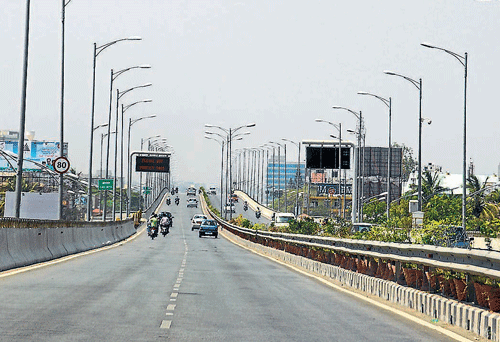
The promoters of Bangalore’s first elevated tollway from Central Silk Board junction to Electronic City, the 9-km, four-lane road, have been registering a loss of Rs five lakh every day.
The tollway, commissioned in 2010 to meet the requirements of the burgeoning IT industry in Electronics City whose captains wanted a freeway to reach office faster, was expected to generate Rs 29 lakh per day as per current revenue target. But, it is fetching Rs 24 lakh a day.
If the original revenue target of Rs 34 lakh per day, decided at the time of the project launch, is taken into account, the loss is in fact higher at Rs 10 lakh per day, sources in the Bangalore Elevated Tollway Limited (BETL), which operates and maintains the tollway, told Deccan Herald. Sources added that a minimum of Rs 29 lakh should be generated each day if BETL is to meet the cost of maintaining the highway and recoup its investment.
The losses are mounting despite a jump in the number of trips on the tollway from 30,000-32,000 a day in 2010-11 to 40,000-45,000 trips per day in 2012-13. The jump in trips, however, has been primarily those of two-wheelers, the sources said, pointing out that the revenue realised from two-wheelers is lower than from cars and heavy vehicles.
A BETL official who did not want to be named said: “The average number of trips in the last three years has gone up by six to eight per cent year on year, but revenues haven’t. This is due to high inflation and rise in petrol prices. Market conditions are making it difficult to break even. I expect we will take another three to five years between 2016 and 2018 to break even provided market conditions turn favourable by then.”
Reasons for losses
The official explained the reasons for fall in the expected revenue. “There is currently a pass system which is offered at discount or which enables one to make multiple trips.
Both are money-losing propositions. In the first, if two trips cost Rs 100, a pass is being offered at Rs 65 for the same. So, we lose Rs 35 for every pass bought. In the latter, if one makes 60 trips on average to office, back and forth, the monthly pass system allows one to make any number of trips over 60, but the car driver pays only for the two trips a day or 60 trips. Is this good economics?”
Tollway officials also say that the NICE road has no pass system at all: One has to pay for each trip separately at whichever point one enters or exits. The officials want the pass system for the tollway cancelled or seek a pass system that allows only two trips at any time, and for further trips, a new pass would have to be purchased. “Let us just follow the NICE system for the tollway too. Revenues will improve automatically. Except for categories of vehicles which are exempted, all others have to pay without discounted passes,” BETL officials proposed.
National policy
The government, however, is not keen on this. It is the National Highways Authority of India (NHAI) under the Ministry of Transport that fixes the rates and decides on the pass system. NHAI fixes rates on a national basis, in which, tollway rates in different cities would be the same. Under this policy, each city is not permitted to have its own rates.
There is no autonomy for the contracted agency to decide rates and the controlling authority for the tollway is the NHAI itself. NHAI’s argument has been that people would use the tollway only if rates are discounted in the initial phases.
The Hosur Road, on which the tollway has been built, sees 80 per cent traffic under the tollway, while the tollway itself sees 20 per cent. While half of the traffic on the tollway is towards Hosur, the other half is into Electronics City. The tollway sees a 50-50 share in the Hosur-Electronics City destinations vehicles travel to. This will have to increase several fold to up revenue or the number of trips each vehicle makes has to go up.